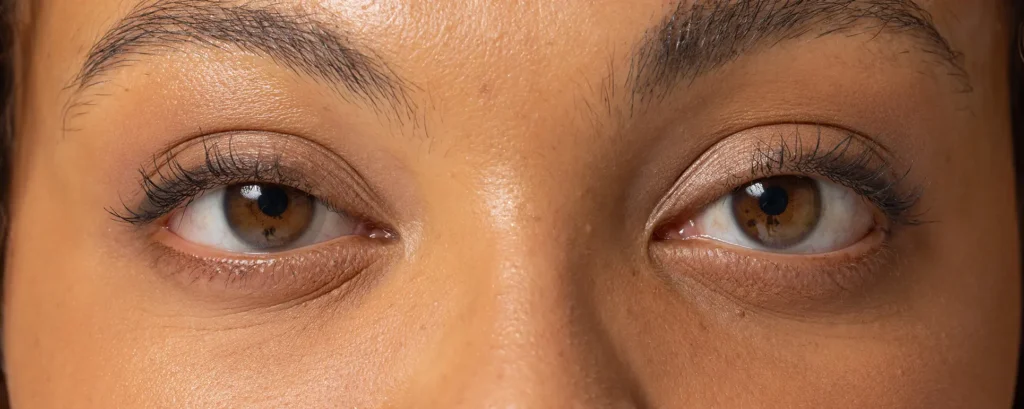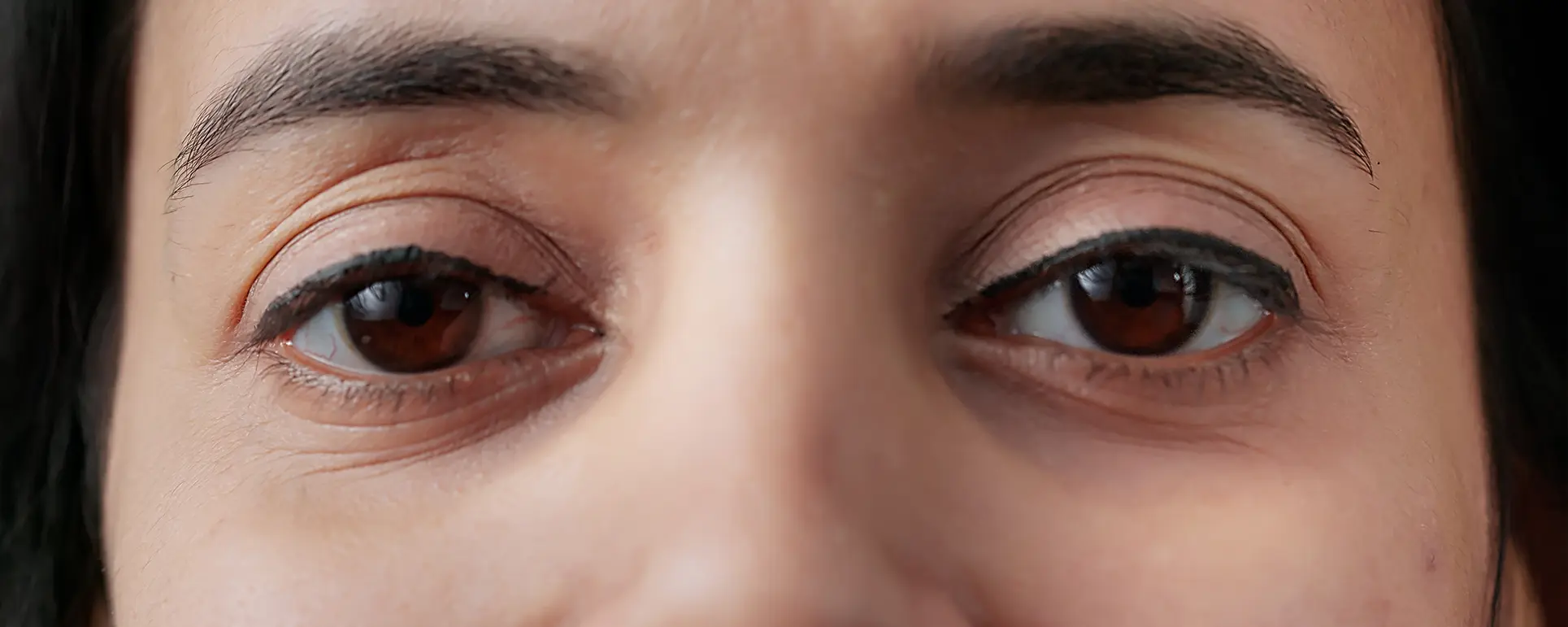You wake up some mornings looking fresh and rested but on others, those dark shadows under your eyes seem more noticeable than ever. Sound familiar?
Many people experience this frustrating fluctuation. Under-eye circles can appear darker, puffier, or more pronounced depending on factors like sleep, hydration, allergies, lighting, and even what you ate the day before.
In this article, I’ll explain why your under-eye circles look worse on some days, the key triggers that cause them to fluctuate, and the best dermatologist-recommended treatments to reduce pigmentation and puffiness for good.
Understanding Under-Eye Circles
Before diving into the causes, it helps to understand what under-eye circles actually are. They’re not all the same in fact, several different mechanisms can make the area appear darker.
The main types include:
- Pigmentation-based circles – caused by excess melanin (skin pigment), often appearing brownish.
- Vascular circles – due to visible blood vessels beneath thin skin, giving a bluish or purplish tone.
- Structural shadows – from hollowness or volume loss under the eyes, which create dark “troughs.”
- Mixed-type circles – a combination of all three, which is common in adults.
Knowing which type you have helps guide treatment, as what works for pigmentation may not work for vascular or structural causes.
Why Your Dark Circles Fluctuate

You might notice your under-eye circles look darker one morning and lighter the next. This variation is normal and it’s influenced by multiple factors.
Here’s what’s happening beneath the surface.
1. Sleep Deprivation (or Too Much Sleep)
Lack of sleep is one of the most common culprits. When you don’t get enough rest:
- Blood vessels under your eyes dilate, causing a bluish tint.
- Poor circulation leads to fluid retention, creating puffiness that casts shadows.
- Your skin becomes paler, making the underlying vessels more visible.
On the other hand, oversleeping can have a similar effect by increasing fluid stagnation. Ideally, aim for 7–9 hours of consistent, good-quality sleep.
2. Dehydration
When you’re dehydrated, your skin loses elasticity and appears duller. Under the eyes, this accentuates fine lines and shadows, making circles look darker.
Even mild dehydration can make a noticeable difference, especially in the morning. Drinking enough water throughout the day and reducing caffeine or alcohol intake helps plump and brighten the delicate under-eye skin.
3. Salt and Alcohol Intake
Ever noticed puffier eyes after a salty meal or a night out? Sodium and alcohol both cause your body to retain water, leading to swelling in the thin skin beneath your eyes.
As this swelling settles, the excess fluid creates shadows that exaggerate dark circles. The effect is usually temporary, but frequent indulgence can make puffiness a regular problem.
4. Allergies and Sinus Congestion
If your dark circles worsen during allergy season or when you have a cold, it’s not your imagination. Allergies cause inflammation and congestion around the sinuses, which can:
- Dilate blood vessels under the eyes.
- Increase swelling and discolouration.
- Make you rub or scratch your eyes, further irritating the skin.
This phenomenon is often called “allergic shiners” because of the purplish tint they create. Managing allergies with antihistamines or nasal sprays can reduce these temporary darkening episodes.
5. Hormonal Changes
Hormones can affect pigmentation and blood flow, which is why some people find their circles worsen during menstruation, pregnancy, or menopause.
Oestrogen levels influence collagen production and vascular dilation. As hormones fluctuate, you may notice your under-eye area looking more tired or darker than usual.
6. Lighting and Shadowing
Sometimes, your circles aren’t actually worse they just look that way because of lighting. Overhead or harsh lighting casts shadows under the eyes, making hollowness or discolouration appear more pronounced.
Natural daylight or soft diffused lighting gives a more accurate picture of your skin tone.
7. Ageing and Collagen Loss
As you age, the skin under your eyes becomes thinner, allowing underlying blood vessels to show through more clearly. Collagen and fat pads that once supported the area also diminish, deepening shadows.
This process happens gradually, but certain days especially when you’re tired or dehydrated can make the effect look more prominent.
8. Genetics and Skin Tone
If your parents have naturally darker pigmentation around the eyes, you’re more likely to have persistent circles. However, genetics can also affect how much your circles fluctuate.
People with medium to darker skin tones often have more melanin in the under-eye region, which can appear darker under fatigue or stress but lighten with proper rest and hydration.
9. Temperature and Weather
Seasonal changes can affect your skin’s hydration and blood flow. Cold weather may cause paler skin, making veins stand out, while hot temperatures can dilate blood vessels, enhancing discolouration.
This is why some people find their circles look worse in winter mornings or during humid summer days.
10. Eye Strain and Screen Time
Hours spent staring at screens cause eye strain and reduced blinking, leading to dryness and puffiness. Over time, this can contribute to fatigue and a darker appearance under the eyes.
Taking regular breaks such as the 20-20-20 rule (every 20 minutes, look 20 feet away for 20 seconds) helps relax the muscles and reduce vascular congestion.
Why Some Days Look Worse Than Others

So why does it seem like your circles have a mind of their own? Because they reflect your body’s daily balance of hydration, sleep, circulation, and inflammation.
When you’re well-rested, hydrated, and relaxed, your under-eye area appears smoother and brighter. But after a stressful, sleepless, or salty day, the tissue retains fluid and blood vessels expand making shadows appear darker.
It’s a visual barometer of your body’s condition, especially since the under-eye skin is just 0.5 mm thick much thinner than elsewhere on your face.
When to See a Dermatologist
While occasional fluctuations are normal, persistent or severe dark circles might signal an underlying issue such as:
- Chronic allergies or sinus problems
- Iron deficiency or anaemia
- Hormonal imbalance
- Thyroid conditions
- Genetic hyperpigmentation
If your under-eye circles remain dark despite good sleep and skincare habits, it’s time to consult a specialist. A qualified cosmetic dermatologist can identify whether your circles are caused by pigmentation, vascular issues, or volume loss and recommend targeted treatments accordingly.
Dermatologist-Approved Treatments for Dark Circles
Depending on the root cause, your dermatologist may recommend one or more of the following treatments.
1. Topical Lightening Creams
Prescription creams containing ingredients like hydroquinone, kojic acid, or retinol can help reduce pigment-based circles by slowing melanin production and improving cell turnover.
2. Chemical Peels
Gentle under-eye peels using lactic acid or glycolic acid can lighten pigmentation, smooth texture, and brighten dull skin.
3. Laser Treatments
Lasers such as Q-switched Nd:YAG or fractional CO₂ can target excess pigmentation and strengthen collagen, helping to thicken the under-eye skin and reduce visible vessels.
4. Dermal Fillers
If your circles are due to hollowing (tear troughs), hyaluronic acid fillers can restore lost volume, reducing shadows and improving light reflection. Results are immediate and last 9–12 months.
5. Microneedling or RF Microneedling
These treatments use micro-injuries or radiofrequency heat to stimulate collagen and tighten thin under-eye skin. They’re particularly effective for ageing-related circles.
6. Platelet-Rich Plasma (PRP)
PRP uses growth factors from your own blood to improve skin texture, increase collagen, and reduce pigmentation naturally. It’s often used in combination with microneedling.
7. Topical Antioxidants
Vitamin C, niacinamide, and peptides help strengthen the skin barrier and reduce oxidative stress that worsens discolouration.
A tailored treatment plan from a dermatologist can address both the cause and appearance of your dark circles safely and effectively.
Skincare Tips for Managing Daily Fluctuations
Even if you pursue professional treatments, consistent at-home care plays a key role in maintaining results and preventing bad “dark circle days.”
1. Prioritise Sleep Quality
Aim for 7–9 hours of consistent rest. Avoid screens at least an hour before bed, and sleep slightly elevated to prevent fluid pooling around your eyes.
2. Stay Hydrated
Drink water throughout the day and limit alcohol or caffeinated drinks that dehydrate your skin.
3. Use a Cooling Eye Cream
Look for products with caffeine, hyaluronic acid, or peptides. Store them in the fridge for an added de-puffing effect.
4. Apply SPF Daily
Sun exposure can worsen pigmentation under your eyes. Use a broad-spectrum SPF 30+ formulated for sensitive areas.
5. Avoid Rubbing Your Eyes
This irritates delicate skin and can lead to inflammation and pigmentation over time.
6. Cold Compresses
A cool compress or chilled tea bags can constrict blood vessels and reduce puffiness within minutes.
7. Watch Your Diet
A balanced diet rich in antioxidants (like berries and leafy greens) supports collagen health and circulation.
Myths About Dark Circles
Let’s clear up a few common misconceptions:
- Myth 1: Only lack of sleep causes dark circles.
Reality: Genetics, allergies, and pigmentation are equally common causes. - Myth 2: Eye creams can erase dark circles completely.
Reality: They can help, but professional treatments are often needed for lasting improvement. - Myth 3: Dark circles mean poor health.
Reality: Not always they can be hereditary or structural rather than a sign of illness. - Myth 4: Drinking more water instantly fixes dark circles.
Reality: Hydration helps, but collagen health and blood circulation are equally important.
Preventing Dark Circles Long-Term
You can’t always control genetics or ageing, but you can reduce triggers that make circles worse.
Here’s how:
- Protect your skin from the sun every day.
- Maintain a regular sleep schedule.
- Reduce salt and alcohol intake.
- Manage allergies and sinus issues early.
- Use gentle skincare products.
- Avoid smoking, which damages collagen and blood vessels.
These habits don’t just help your eyes they also benefit your overall skin health.
When Lifestyle Changes Aren’t Enough
If you’ve tried lifestyle adjustments, creams, and good sleep but your circles still fluctuate, you may be dealing with deeper pigmentation or structural concerns.
That’s when seeing a cosmetic dermatologist is the right step. With advanced diagnostic tools, they can identify the true cause of your dark circles whether it’s pigment, volume loss, or vascular visibility and create a customised treatment plan for lasting improvement.
FAQs About Under-Eye Circles:
1. Why do my under-eye circles look worse in the morning?
You may notice your dark circles more prominently in the morning because fluid can accumulate overnight. This causes puffiness that casts shadows under your eyes. Blood vessels may also dilate while you sleep, making the area appear darker. Sometimes, dehydration from not drinking enough water before bed or sleeping in a warm room can accentuate these effects.
2. Can lack of sleep alone cause dark circles?
Sleep deprivation is a significant factor, but it’s rarely the only one. When you’re tired, your blood vessels dilate and circulation slows, making the under-eye area look bluish or purplish. However, genetics, pigmentation, allergies, and thinning skin can all contribute, so you might still see dark circles even after a full night’s rest.
3. How do allergies make my under-eye circles worse?
When you have allergies, inflammation and sinus congestion increase around your eyes. This can dilate the tiny blood vessels under the skin, leading to puffiness and a purplish hue. Rubbing or scratching the area due to itchiness can also worsen pigmentation over time. Managing your allergies with appropriate treatments can help minimise these temporary darkening episodes.
4. Are my dark circles hereditary?
Yes, genetics can play a big role in how your under-eye area looks. If your parents have naturally darker pigmentation or hollows under the eyes, you’re more likely to have similar traits. Skin tone also influences visibility; people with more melanin in their skin may notice more fluctuation in darkness depending on sleep, hydration, or stress.
5. Do topical creams really help under-eye circles?
Topical creams can be effective for certain types of dark circles, especially those caused by pigmentation. Ingredients like retinol, vitamin C, or niacinamide can help stimulate collagen, improve skin texture, and reduce melanin production. However, they may not fully resolve circles caused by hollowness, vascular issues, or deep structural shadows. In those cases, professional treatments are often needed.
6. When should I see a dermatologist about my dark circles?
You should consult a dermatologist if your under-eye circles persist despite getting enough sleep, staying hydrated, and using proper skincare. A specialist can determine if pigmentation, vascular visibility, or volume loss is the cause. They can also recommend personalised treatments to safely reduce darkness and improve the overall appearance of your eyes.
7. Can diet and lifestyle changes make a noticeable difference?
Absolutely. Maintaining good hydration, limiting alcohol and salt intake, getting consistent sleep, and protecting your skin from sun exposure can significantly reduce daily fluctuations. A diet rich in antioxidants, vitamins, and minerals supports collagen production and healthy circulation, which can help your under-eye area look brighter over time.
8. How does ageing affect under-eye circles?
As you age, the skin under your eyes becomes thinner and loses collagen and fat. This makes underlying blood vessels more visible and can create hollow areas that cast shadows. You might notice that your dark circles become more persistent or pronounced, especially on days when you’re tired, dehydrated, or stressed.
9. Are there non-invasive treatments for under-eye circles?
Yes, there are several options. Treatments like dermal fillers, microneedling, RF microneedling, PRP, and laser therapies can address specific causes like volume loss, pigmentation, or thin skin. Your dermatologist will guide you to the most suitable treatment depending on whether your circles are vascular, pigmented, or structural in nature.
10. Can dark circles completely go away?
In many cases, you can significantly improve the appearance of dark circles, but complete removal isn’t always possible, especially if genetics or deep structural shadows are involved. Consistent at-home care combined with professional treatments can make a noticeable difference and help you maintain a brighter, more refreshed under-eye area.
Final Thought: How to Manage Your Dark Circles
Dealing with under-eye circles that seem to change day by day can be frustrating, but there are ways you can take control. Focusing on sleep, hydration, diet, and sun protection can help your eyes look brighter and more refreshed. If you find that these changes aren’t enough, a cosmetic dermatologist can work with you to pinpoint the cause whether it’s pigmentation, vascular visibility, or volume loss and suggest treatments that improve your under-eye area safely and effectively.
If you’d like to book a consultation with one of our dermatologists, you can contact us at the London Dermatology Centre to discuss personalised options for dark circles under eyes.
References:
1. Park, K.Y. (2018). ‘Treatments of Infra-Orbital Dark Circles by Various Etiologies’, PMC. Available at: https://pmc.ncbi.nlm.nih.gov/articles/PMC7992473/
2. Freitag, F. M. (2007). What causes dark circles under the eyes? Journal of Clinical and Aesthetic Dermatology, 1(7), 24–30. Available at: https://pubmed.ncbi.nlm.nih.gov/17760701/
3. Mac-Mary, S., et al. (2019). Identification of three key factors contributing to the occurrence of infraorbital dark circles. Clinical, Cosmetic and Investigational Dermatology, 12, 1–9. Available at: https://pubmed.ncbi.nlm.nih.gov/31908515/
4. Vrcek, I., Ozgur, O., & Nakra, T. (2016). Infraorbital dark circles: A review of the pathogenesis, evaluation and treatment. Journal of Cutaneous and Aesthetic Surgery, 9(2), 65–72. Available at: https://pmc.ncbi.nlm.nih.gov/articles/PMC4924417/
5. Goldman, A. (2021) ‘Periorbital hyperpigmentation Dark circles under the eyes’, Cosmetics, 8(2), 26. Available at: https://www.mdpi.com/2079-9284/8/2/26
